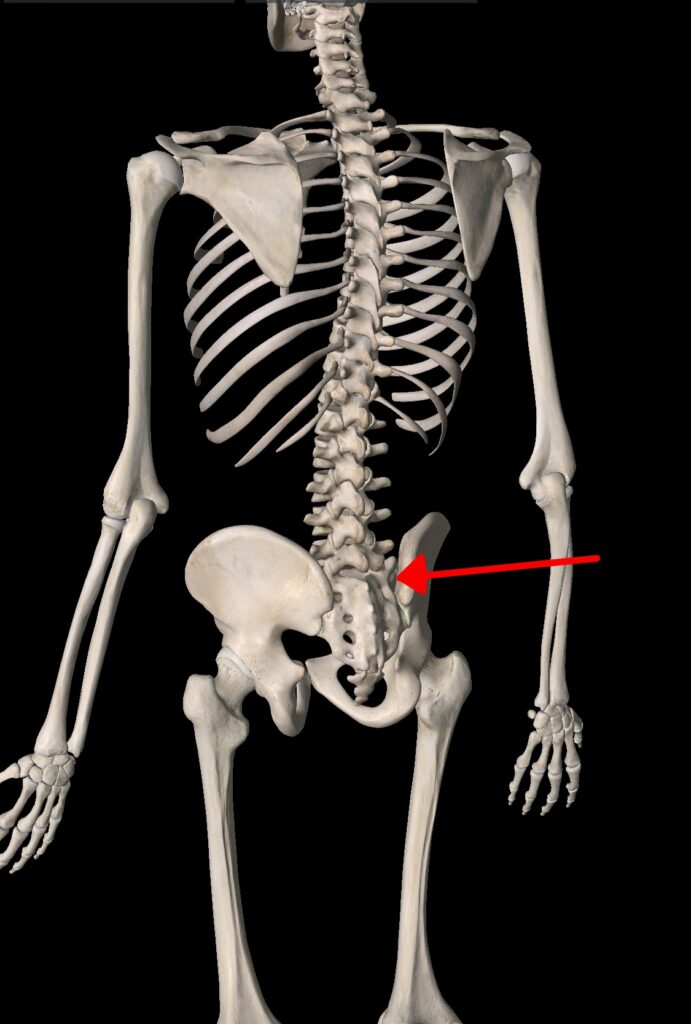Sacroiliac Joint Dysfunction
Lower back and sacrum pain is a common condition that may be caused by dysfunction in the sacroiliac joints—important joints in the lower back that help support the spine and pelvis. Back joint pain from SIJ dysfunction accounts for up to 25% of patients reporting lower back pain. (1).
Sacroiliac Joint Dysfunction is a broad term that refers to abnormal biomechanical function of the SIJ, or in other words, the joint/s are not moving or behaving how they are supposed to.
Symptoms of SIJ dysfunction include: (2)
- Pain over one side of the lower back, below waist height
- Pain in the buttock of the affected side
- Pain may refer into the back or side of the thigh on affected side
- Aggravated by rising from a chair; and
- Aggravated by standing still and walking.
What Are Sacroiliac Joints
Sacroiliac joint
The SIJs help to connect our legs to our spine, via our pelvic bones. They consist of our sacrum and ilium connecting together. We have two of these joints (SIJs) in our pelvis, and are classified as synovial joints (3).
The lower back joints, including the sacroiliac joints, play a crucial role in supporting weight and enabling functional movement. These joints rely on strong SIJ ligaments to maintain stability. When these ligaments become strained or inflamed, it can lead to pain in the lower back and sacrum that may feel sharp, dull, or radiating.
The joints are covered by a joint capsule and have an extensive network of ligaments holding them together. Muscles such as the gluteal muscles (buttock), iliopsoas, hamstrings, and piriformis assist in stabilising these joints.
The main function of the SIJs is to provide stability to our pelvis and distribute load from our upper body into our lower body (and vice versa). They act as shock absorbers and deal with heavy compressive forces generated from walking, running, jumping, bending and weight bearing (4).
Causes of SIJ Dysfunction
Some causes include: (3)
- Trauma. Motor vehicle accidents, falls, or repetitive trauma due to activities like work, lifting and sports are the most common examples of trauma which can lead to SIJ dysfunction. Traumatic events can damage the SIJ ligaments, leading to joint instability and recurring back pain in the sacrum or pelvis.
- Hypermobility. This can be hereditary or associated with some medical conditions.
- Pregnancy. Hormonal changes cause slackening of the SIJ ligaments and contribute to instability / hypermobility.
- Abnormal function of lower limb joints and musculoskeletal tissue. People with altered walking (gait) patterns and issues creating asymmetry can have reduced sacroiliac locking ability leading to joint instability.
- Leg length discrepancy (uneven leg lengths). Anatomical differences in bone length in our legs cause altered weight bearing load through our SIJs.
- Osteoarthritis. SIJs are a very common location for degenerative changes. Age and previous trauma are risk factors which increase the incidence of degenerative changes / osteoarthritis.
- Abnormal movement in the lower back joints, especially when paired with weak SIJ ligament support, can lead to recurring pain and stiffness.
- Inflammation. When present in the SIJs, inflammation is known as Sacroiliitis. It may be associated with infection or with some inflammatory conditions. Certain types of arthritis, such as rheumatoid arthritis and ankylosing spondylitis, can cause sacroiliitis.
Diagnosis
This condition can look very similar to other lower back problems such as mild disc bulge, facet joint sprains and muscular strains of the lower back. The diagnosis of SIJ dysfunction begins with the health practitioner having a detailed discussion with the patient about the issue. This will often shed light on the potential cause, triggering event, risk factors and help lead to an accurate evaluation of the patient.
The health practitioner will then proceed to examine the patient and perform specific tests to determine the source of the back pain.
X-Rays or other imaging can assist in making a diagnosis by either confirming or ruling out potential causes.
Treatment
Treating joint pain in the back and sacrum may involve multiple approaches, especially when SIJ dysfunction or ligament instability are present. Chiropractic care may include:
- Sacroiliac Joint mobilisation. Restoring correct movement dynamics to the effected joint and surrounding tissues aid in reducing pain significantly for many individual(5).
- Treatment directed to supporting muscle tissue. This could include hands on work such myofascial releases, stretches. Or electro-physical therapies such as shockwave therapy and low level laser therapy.
- Home based exercises and stretches to assist with speedy recovery and prevent future occurrences.
Want to know more?
If you’re experiencing joint pain in your lower back, discomfort around the sacrum, or symptoms related to SIJ ligament dysfunction, our chiropractors can help. Contact Spine Sport Feet clinic in Helensvale Homeworld on (07) 5580 5655 or book online for a personalised assessment.
FAQs
Q: What causes joint pain in the lower back and sacrum?
A: Common causes include sacroiliac joint dysfunction, ligament strain, arthritis, poor posture, and trauma. These conditions affect how the back joints and SIJ ligaments function.
Q: Are SIJ ligaments important for spinal stability?
A: Yes, SIJ ligaments stabilise the sacroiliac joints and prevent excessive movement. When compromised, they can cause persistent lower back and sacrum pain.
Q: What are common symptoms of SIJ-related back pain?
A: Symptoms may include pain in the buttock, stiffness in the lower back joints, and discomfort when walking, standing, or rising from a seated position.
REFERENCES
- Cohen SP. Sacroiliac joint pain: a comprehensive review of anatomy, diagnosis, and treatment. Anesth Analg. 2005 Nov;101(5):1440-1453.
- https://www.spinemd.com/what-we-treat/back/sacroiliac-joint-pain
- Chuang CW, Hung SK, Pan PT, Kao MC. Diagnosis and interventional pain management options for sacroiliac joint pain. Ci Ji Yi Xue Za Zhi. 2019 Oct-Dec;31(4):207-210. [PMC free article: PMC6905244]
- Vleeming A, Schuenke MD, Masi AT, Carreiro JE, Danneels L, Willard FH. The sacroiliac joint: an overview of its anatomy, function and potential clinical implications. J Anat. 2012 Dec;221(6):537-67. [PMC free article: PMC3512279] [PubMed: 22994881]
- Kamali F, Shokri E. The effect of two manipulative therapy techniques and their outcome in patients with sacroiliac joint syndrome. J Bodyw Mov Ther. 2012 Jan;16(1):29-35.







